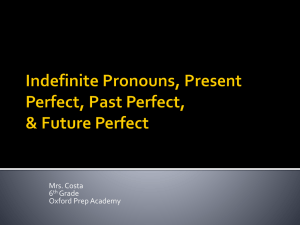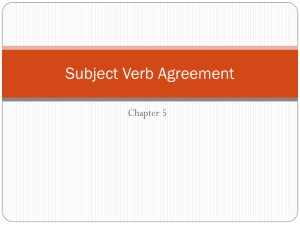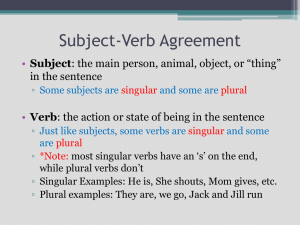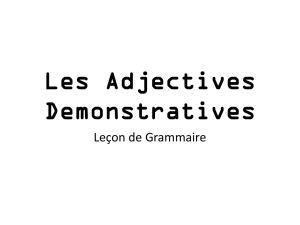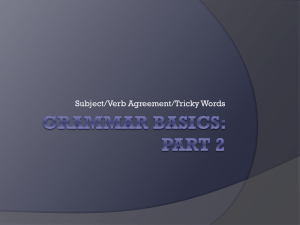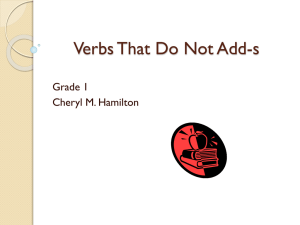Subject-Verb Agreement
advertisement
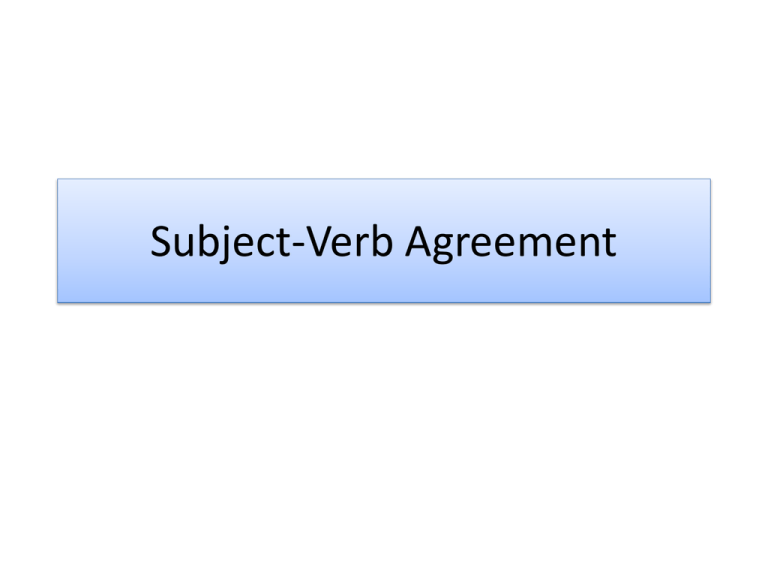
Subject-Verb Agreement Number When a word refers to one person, place, thing, or idea, it is singular in number. When a word refers to more than one person, place, thing, or idea, it is plural in number. The basic rule: a verb should agree in number with its subject. On that route, the airplane flies at a very low altitude. Airplane flies, NOT airplane fly. Why people get confused by this: the singular verbs usually end in “s,” which is the opposite of what we’re used to, since objects that are plural usually end in “s.” Don’t over think this stuff: go with your instincts first. Number in verb phrases In a verb phrase, it’s the helping verb that expresses the number. He is building a bird feeder. (Is, not are) Does anyone know the answer? (does is singular, do is plural) Do any students know the answer? Problems in Agreement The number of a subject is not changed by a phrase or a clause following a subject. The distance between the two posts is eight feet. Karen’s brother, who has always enjoyed bicycle repair and maintenance, works at the bike shop on weekends. An exception to the rule: if the subject is the indefinite pronoun all, any, more, most, none, or some, the number may be determined by the object of the phrase that follows. (The reason is because we’d have to know what we have all of, or some of, or most of, etc. in order to make our verb agree.) All of the desks were in straight lines. (All is the subject, but we need to know what we have all of (one thing or many things). In this case, we are taking about all of the desks, so we need a plural verb.) All of the carpet was installed last night. (All is referring to one thing – carpet) Agreement with Indefinite Pronouns The following indefinite pronouns are singular: Anybody, anyone, anything, each, either, everybody, everyone, everything, neither, nobody, nothing, no one, one somebody, someone and something. Everyone was invited to the celebration. Either of the answers is correct. Note the difference between an indefinite pronoun that is acting as the subject and the same word merely being an adjective: Either answer is correct. One of the tapes belongs to Sabrena. Someone in the stands has been waving at us. Indefinite pronouns, cont’d The following pronouns are plural: Both, few, many, and several. Both of the apples are good. Few know about the surprise. Many of the students walk to school. The indefinite pronouns all, more, most, none, and some may be singular or plural, depending on their meaning in a sentence. All of that fruit looks ripe. (All refers to one thing – fruit – so it takes a singular verb.) All of the pears look ripe. (All refers to several things, so it takes a plural verb) Compound Subjects Subjects joined by and usually take a plural verb. Last year a library and a museum were built in our town. Don and Tom are the team captains. Sometimes, subjects joined by and can be considered one thing (in cases where two things are usually named together or are separate things served together, as in food, also in cases where one subject has two different qualities) The secretary and treasurer of the science club is Leona. (Leona is one person who holds two different titles – she’s an overachiever like that.) Chicken and dumplings is a favorite Southern meal. (Multiple food items, but they’re served together as one dish.) Either/or, Neither/nor) Singular subjects joined by or/nor take a singular verb. Plural subjects joined by or/nor take a plural verb. A pen or a pencil is needed for this test. Neither Miami or Jacksonville is the capital of Florida. Are the Bulldogs or the Mustangs winning the game? If either/or, neither/nor are joining a singular subject and a plural subject, the verb agrees with the subject that is closer to the verb. Neither the manager nor the employees want to close the store early. (Note: “Manager” and “employees” are both the subject, but only “employees” would be used for verb agreement) Inverted (Backward) Sentences When a sentence’s structure is backward (meaning the verb appears before the subject), make sure you are making the verb agree with the actual subject. There is an exciting ride at the fair. There are exciting rides at the fair. Why we screw this one up: We like to slide our verb into a contraction when we speak; however, this prevents us from hearing the actual verb that we’re trying to say, so we will say things like this: “There’s exciting rides at the fair.” – What you’re actually saying is “There is exciting rides at the fair.” There is not the subject – rides is the subject. Don’t/Doesn’t Doesn’t is singular. Don’t is plural. These gloves don’t fit. He doesn’t want to be late. Why we screw this up: Living in the Midwest, and being surrounded by country music, we are bombarded by the “hick talk” version of grammar: He don’t want to talk to you. It don’t matter. Bottom line: reinforce good grammar by saying the RIGHT verb when you write and speak. Collective Nouns Collective nouns may be singular or plural, depending on their meaning in a sentence. A collective noun is singular when the group is functioning as one unit: The team practices every day after school. (Everyone doing the same thing) A collective noun is singular when the individual members of the group are each doing his or her own thing (plural to accentuate the multiple members who are NOT working as a unit) The class are creating projects about volcanoes. (Each individual class member is creating a project, so the verb is plural to show the existence of multiple projects) The team have been strength training to improve skills. (Not all team members are doing the same type of strength training) Fractions and Amounts An expression of an amount may be singular or plural, depending on how it is used. An amount is singular when it is thought of as one unit: Three years is a long time. (Three years as a lump of time together).) Three years in particular were difficult for the family. (Three separate years = accentuating the multiple years) A fraction or percentage is singular when it refers to a singular word and plural when it refers to a plural word. Two thirds of the city council was at the meeting. (Two thirds is the subject, but you have to know what you have 2/3 of – one thing or many things) Two thirds of the city council members were present. Fractions and Amounts, cont’d Expressions of measurement (length, width, or height) are usually singular. Ten feet of yarn is needed for this art project. Two gallons of that paint covers approximately two hundred square feet. Three pounds is the net weight of this bag of almonds. Nouns Plural in Form Some nouns are plural in form but take singular verbs. Civics Economics Electronics genetics gymnastics mathematics measles molasses mumps Hey, the news is on! Economics is my sister’s favorite subject. Gymnastics is a sport requiring a lot of upper body strength. news physics summons Nouns Plural in Form, cont’d Some nouns are plural in form and name singular objects, but they do take plural verbs: Binoculars Eyeglasses Olympics pants pliers scissors The binoculars have complicated controls. The slacks are torn in two different spots. The pliers belong in the toolbox. shears shorts slacks Titles of Creative Works Titles of creative works (book, song, movie, painting, poem) or the name of a country, city, or organization generally takes a singular verb. Cedar Rapids is a manufacturing center in the Midwest. Friends of the Earth was founded in 1969. Blue Lines is an early Georgia O’Keeffe panting. Predicate Nominatives Don’t let a predicate nominative confuse your choice of verb. Verbs should agree with their subjects. The best time to visit is weekday mornings. Weekday mornings are the best time to visit.

